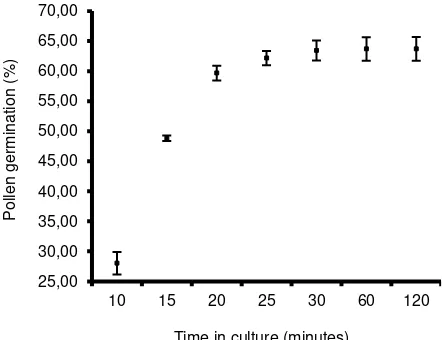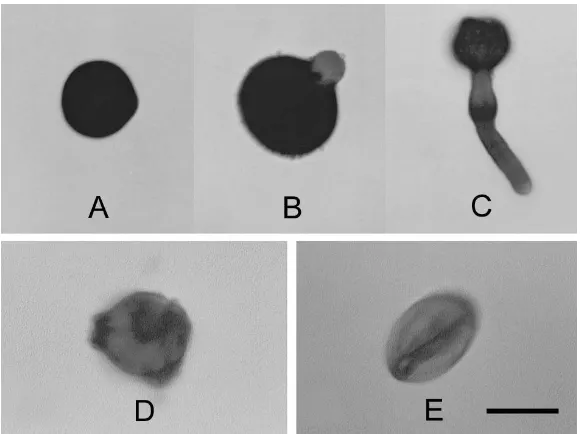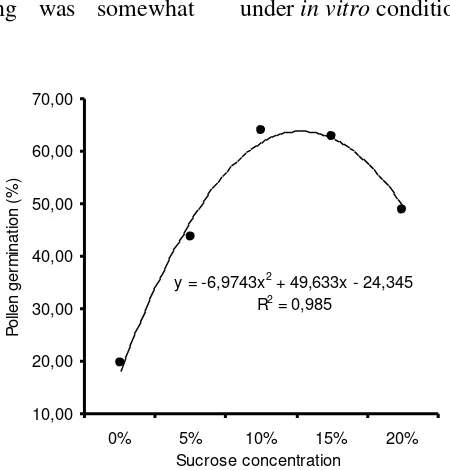Tanaman Tropika 8(2): 95-101, Oktober 2005 ISSN 1410-7368
95
POLLEN VIABILITY ASSESSMENT IN
Swainsona formosa
(G.Don)
J.Thompson*
Zulkarnain
Agricultural Faculty University of Jambi - Kampus Pinang Masak, Mendalo, Jambi 36361 Phone/fax: +62 741 582781
Email: [email protected]
Abstrak
Percobaan ini bertujuan untuk mendapatkan waktu yang paling tepat (setelah penaburan) untuk mengukur viabilitas serbuk sari, dan untuk mengetahui pengaruh berbagai tingkat konsentrasi sukrosa terhadap perkecambahan serbuk sari Swainsona formosa. Laju pembentukan buluh serbuk sari ditentukan pada interval 10, 15, 20, 25, 30, 60 dan 120 menit terhadap serbuk sari segar yang diperoleh dari tanaman di rumah kaca dan dikulturkan pada medium Brewbaker dan Kwack (BK). Hasil percobaan menunjukkan bahwa dalam waktu 60 menit jumlah serbuk sari yang berkecambah mencapai 63,70%, yang kemudian berada pada laju yang tetap (63,71) setelah 120 menit. Di bawah pengaruh berbagai tingkat konsentrasi sukrosa, yakni 0,5, 10, 15 dan 20% (b/v), laju perkecambahan serbuk sari diukur setelah 60 menit penaburan. Hasilnya menunjukkan bahwa konsentrasi sukrosa antara 10 hingga 15% (b/v) menghasilkan laju perkecambahan yang lebih baik (64,14%) dibandingkan konsentrasi yang lebih rendah (19,64 dan 43,58% pada konsentrasi sukrosa nol dan 5%). Sementara itu, konsentrasi sukrosa di atas 15% cenderung untuk menghambat perkecambahan serbuk sari (48,92% pada konsentrasi sukrosa 20%).
Kata kunci: viabilitas serbuk sari, Swainsona formosa, tanaman hias.
INTRODUCTION
Swainsona formosa belongs to the subfamily Papilionoideae of the family Fabaceae. It grows mainly in arid regions of southern and central Australia (Williams and Taji, 1987; 1991) in South Australia and also occurs in New South Wales, the Northern Territory and Western Australia (Kirby, 1996b; 1996a), particularly on alkaline soils of areas receiving extra water,
* This paper is part of PhD Thesis at the University of New England, Armidale, Australia, 2003.
such as creek or lake margins (Bindon, 1996).
required for flowering (Kirby, 1996b). The optimum temperature is 32.5 ± 2.5 oC, and plants will grow slowly if temperature is below 20 oC (Kirby, 1996a). Plants grown
under temperature of 18/30 oC (night/day)
produced more flowers than those grown under 10/22 oC (night/day) or a constant
temperature of 25 oC (Yusuf et al., 2002).
The economic importance of S. formosa is in its potential use in a hanging basket or container plant, or as a cut flower plant (Williams and Taji, 1991; Kirby, 1996b; 1996a). A market survey conducted by South Australian Agriculture revealed that Japan is one of the most important cut flower markets in the world to which S. formosa has already been exported (Barth and Bennel, 1989).
The commercialization of S. formosa,
however, is hampered by the production of large amount of pollen grains, which may stains the petals when the anthers dehisce, resulting in poor flower quality. Post-harvest self pollination may also occur during transportation, causing quick flower degeneration and reduction in vase-life. Therefore, the breeding programmed of this species should be focused on the crossing effort to produce hybrids with less or non-viable pollen grains. One of essential requirement in crossing is to have a method of testing pollen viability with a reasonable
level of accuracy. We report here the study of pollen viability as an initial step in breeding of S. formosa.
MATERIALS AND METHODS
1. Stock plants establishment
Plant materials were routinely grown on sand and peat (3:1) medium in a glasshouse with an average temperature of 25 – 32 oC, light intensity of 650 – 1200
µmol m-2 s-1, and photoperiod of 12 – 16 hours. Plants were watered once a day using an automatic watering system. Approximately 250 mL supplementary liquid fertiliser with trace elements, Hortico™ Aquasol™ (23% N, 4% P, 8% K, 0.05% Zn, 0.06% Cu, 0.0013 Mo, 0.15% Mn, 0.06% Fe and 0.11% B), was applied weekly at a concentration of 1 g L-1. After the plants had been four weeks in the new pots, a fungicide (Fongarid® 250WP with active ingredient 25% furalaxyl) was applied at a concentration of 1 g L-1 to
eliminate root diseases such as Phytopthora
sp. A slow release fertiliser, Nutricote®
-Tanaman Tropika 8(2): 95-101, Oktober 2005 ISSN 1410-7368
97
1 to kill the spider mite (Tetranychus sp.) as
required. In addition, an insecticide Clear White Oil (active constituent 820 g L-1
petroleum oil) was applied at 0.2% (v/v) to kill mealy bug.
2. Rate of pollen tube formation
Flowers on the second day of anthesis were selected from 5 different stock plants. Dry mature pollen grains from each individual flower from 3 – 4 umbels were collected in a small glass vial and mixed thoroughly. Pollen viability and rate of pollen tube formation were tested at different times, i.e. 5-10, 11-15, 16-20, 21-25 and 26-30 minutes after being plated. Pollen germination was undertaken on BK medium (Brewbaker and Kwack, 1963) microscope slide. The slides were placed in closed Petri dishes on a layer of moistened filter paper. The dishes were maintained at room temperature (25 ± 1 oC) and light
intensity of 50 µmol m-2 s-1 to allow the
pollen to germinate.
The assessment of pollen viability was done using aceto-orcein staining
technique (Prakash, 2000) under a light microscope (Zeiss Standard-20). The viable pollen grains will develop pollen tubes and absorb more stain, and therefore, they are darker in colour. In contrast, unviable pollen grains will not develop pollen tubes and absorb less stain, resulting in lighter colour.
3. The effect of sucrose concentrations
on pollen tube formation
In this trial pollen grains were collected in the same way as the previous trial, germinated on the same medium composition but with different sucrose concentrations, i.e. 0, 5, 10, 15 and 20% (w/v), and kept under similar environmental conditions as the previous experiment. The observation on pollen tube growth was done following 60 minutes of plating.
RESULTS AND DISCUSSION
1. Pollen germination
The result of in vitro germination attempted on BK medium (Brewbaker and Kwack, 1963) containing 10% (w/v) sucrose is presented on Figure 1. Pollen tubes started to grow within the first 10 minutes of culture (28.3% pollen tube formation) but the length of most pollen tubes was less than half of the respective pollen diameter. Tube formation increased dramatically within the next 10 minutes (48.84%) and remained steady after 60 and 120 minutes, after the pollen was initially spread (63.70 and 63.71% pollen germination, respectively). Based on these results, pollen germination on the next trial was assessed at 60 minutes after culture.
The use of aceto-orcein was proven to be useful in determining viable or unviable
pollen grains. The work presented here showed that viable pollen grains absobed more stain along with the development of pollen tubes. On the other hand, unviable pollen grains abserbed less stain and did not develop pollen tube (Figure 2). Prakash (2000) suggested that there are various methods of pollen viability test, such as tetrazolium test, fluorochromatic reaction (FCR) test, or Feulgen staining test. However, there is no universal viability test that reliable for all plant species. Treating the pollen grains with non-vital stains such as aceto-carmine, iodine in potassium iodide, and aniline blue in lactophenol essentially imparts color to the contents of the pollen in fresh as well as fixed/dead pollen. Our results showed that aceto-orcein could be reliably used to determine the viability of S. formosa pollen grains.
Figure 1. The percentage of germination of S. formosa pollen at various times after culture initiation. Bars indicate standard deviations of five replicates.
25,00 30,00 35,00 40,00 45,00 50,00 55,00 60,00 65,00 70,00
10 15 20 25 30 60 120
Pol
len germi
nati
on
(%
)
Tanaman Tropika 8(2): 95-101, Oktober 2005 ISSN 1410-7368
99
Figure 2. The growth of pollen tube on BK medium supplemented with 10% sucrose. A, pollen grain at the time of culture initiation; B, ten minutes after germination; C, sixty minutes after germination; D and E, examples of unviable pollen grains. Bar A = 15 µm, B, D, E = 10 µm, C = 25 µm.
2. The effect of sucrose concentration
With sucrose concentrations of 10 – 15% (w/v), pollen tubes started to grow just within a few minutes after being plated, indicated by a swelling germinal pore (Figure 2A). Following 10 minutes of germination, the length of the tubes reached a half pollen diameter (Figure 2B). Within the next 30 minutes the rate of tube growth increased rapidly and most pollen produced a tube length approximately 1.5 times the pollen diameter. About sixty minutes after germination most pollen tubes reached a length of 3 – 4 times the pollen diameter (Figure 2C).
Analysis of variance on the effect of sucrose on in vitro pollen germination showed that the number of germinating
comparable to the report of Polito and Luza (1988), on Pistachio vera (also a leguminous plant), where there was no differences in germination of fresh pollen on 10%, 15% or 20% sucrose. However, with time, 20% sucrose consistently support higher pollen germination level on this plant. Their finding was somewhat
contradict with the present result, where the rate of in vitro pollen germination on S. formosa significantly dropped on 20% sucrose.
Figure 3 shows the relationship of various concentrations of sucrose and the rate of pollen germination in S. formosa
under in vitro condition.
Figure 3. The relationship of various sucrose concentrations and the rate of pollen germination in S. formosa.
CONCLUSION
Based on the results of this study, it can be concluded that: 1) the proper time to determine pollen viability under in vitro
condition in Swainsona formosa is 60 minutes after pollen culture in BK medium, and 2) sucrose concentration of 10 – 15% (w/v) is recommended to be incorporated in the germination medium for pollen viability test.
REFERENCES
Barth, G. 1990. Cut flower potential of Sturt's Desert Pea. Australian Horticulture 88: 48-53.
Barth, G. E. and M. Bennel. 1989. Market Development of Sturt's Desert Pea (Clianthus formosus) for The Cut Flower Market in Japan. Research Report South Australia Department of Agriculture, Adelaide.
Tanaman Tropika 8(2): 95-101, Oktober 2005 ISSN 1410-7368
101 Brewbaker, J. L. and B. H. Kwack. 1963.
The essential role of calcium ion in pollen germination and pollen tube growth. American Journal of Botany 50: 859-865.
Kirby, G. C. 1996a. Sturt's desert pea as cut flower crop. Proceedings of 4th
National Workshop for Australian Flower. Perth, Australia, 26 September 1996. pp. 204-209.
Kirby, G. C. 1996b. Sturt's desert pea for pot plant and hanging baskets.
Proceedings of 4th National Workshop
for Australian Flower. Perth, Australia, 26 September 1996. pp. 44-48.
Petersen, R. G. 1985. Design and Analysis of Experiments. Marcel Dekker, Inc., New York.
Polito, V. S. and G. Luza. 1988. Longevity of pistachio pollen determined by in vitro germination. Journal of American Society for Horticultural Science 113: 214-217.
Prakash, N. 2000. Methods in Plant Microtechnique. University of New England, Armidale, Australia.
Williams, R. R. 1996. Swainsona formosa,
(Clianthus, Sturt's desert pea), family Fabaceae (Leguminosae). In K. A. Johnson and M. Burchett [eds.], Native Australian Plants: Horticulture and Uses. University of New South Wales Press, Sidney, Australia.
Williams, R. R. and A. Taji. 1987. Propagation of Sturt's Desert Pea by seed, cutting and tissue culture. Australian Horticulture 85: 47-53. Williams, R. R. and A. Taji. 1991. Sturt's
Desert Pea in review. Australian Horticulture 89: 85-88.


